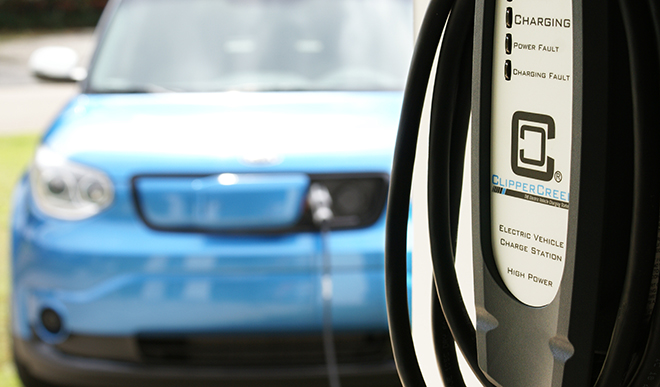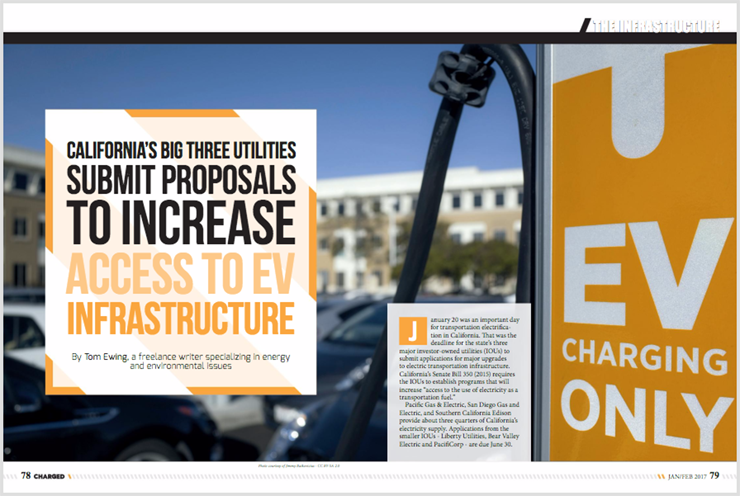January 20 was an important day for transportation electrification in California. That was the deadline for the state’s three major investor-owned utilities (IOUs) to submit applications for major upgrades to electric transportation infrastructure. California’s Senate Bill 350 (2015) requires the IOUs to establish programs that will increase “access to the use of electricity as a transportation fuel.”
Pacific Gas & Electric, San Diego Gas and Electric, and Southern California Edison provide about three quarters of California’s electricity supply. Applications from the smaller IOUs – Liberty Utilities, Bear Valley Electric and PacifiCorp – are due June 30.
Last September, California’s Public Utility Commission (PUC) issued a lengthy document, written by Commissioner Carla Peterman, describing what the IOU applications should contain. This complex document cross-references multiple energy and transportation programs, from reducing petroleum use to stimulating innovation and competition. In something of an understatement, Commissioner Peterman wrote that “the electric utilities will need to think outside of the box on how they can provide electricity to fuel vehicles, integrate and maximize the use of renewable energy, and accelerate the adoption of transportation electrification in order to achieve the multiple objectives outlined by SB 350.”
Peterman lists some priorities:
- Light-duty vehicles: New projects need “to be different” from existing pilot projects, which, the IOUs are cautioned, should not just be scaled up until results are checked.
- Rates: Shifting costs among ratepayer classes may not be a viable solution.
- Environmental justice and benefits within disadvantaged communities.
- Leveraging resources: Transit electrification, for example, can provide neighborhood air-quality benefits and draw upon “other funding sources.” Or, plans for ports and freight may be a good starting point because single owners control many vehicles.
- Vehicle-to-grid communication interface (VGI): Applications should reference program compliance with the ISO/IEC 15118 VGI Standard; or plans must justify alternative approaches.
So, what did the three IOUs propose to jump-start big shifts in private sector transportation investments?
Each utility’s application has two core sets of ideas: “priority review” programs and “standard review” programs.
The priority programs are relatively quick and easy. However, they are deliberately limited by the PUC: each priority project must cost less than $4 million and, altogether, cannot total more than $20 million for each utility. Allowing “priority” projects is important, though, because PUC’s review will likely take all of 2017. Priority projects can at least get some actual work started relatively quickly. But importantly, priority projects are not viewed as hefty enough to fulfill the requirements of SB 350. Those more substantive ideas are within the “standard review” category.

Priority projects
SCE proposes six priority projects, totaling $19.45 million, including rebates for residents to install EV charging infrastructure, an EV rideshare reward and electrifying freight equipment at the Port of Long Beach.
PG&E and SDG&E suggest similar proposals: electrifying airport ground equipment, charging infrastructure for electric delivery vehicles and a rate (fee) to encourage rideshare drivers and services to use EVs. PG&E would spend $20 million, SDG&E $18.2 million.
Priority projects will undergo PUC review – they are not shoo-ins. But they won’t receive the same extensive scrutiny as the “standard review” projects.
Standard review
Here’s a brief summary of the IOUs’ big-picture ideas. The PUC will closely evaluate whether they present the kinds of programs and investments that will start an unstoppable demand for electricity as a transportation fuel.
San Diego Gas & Electric
SDG&E proposes to spend $226 million, over five years, for 90,000 in-home Level 2 (L2) charging stations, paying for installation and maintenance, although there is a cost cap. The offer is paired with a customer requirement to sign up for a residential “grid integrated rate,” a combination designed to promote renewable energy development and efficient grid operations and to save money. (High-energy programs present technical challenges, so the reference to “efficient grid operations” is important.) At least 20% of installations would be set aside for disadvantaged communities.
SDG&E expects the L2 program will increase EV demand and lead to “market expansion opportunities for all market participants.” The program would remove “a significant barrier to more rapid EV market growth: lack of consumer confidence in convenient and cost-effective charging.” The utility believes the plan provides the environmental, safety, equal access and grid management benefits consistent with SB 350.
Pacific Gas & Electric
In northern California, PG&E seeks two major programs. One proposes $22 million in rebates to help purchase DC fast chargers in disadvantaged communities.
The second would build out PG&E’s FleetReady program, which provides “make-ready infrastructure to support the accelerated electrification of non-light-duty electric vehicles,” e.g. trucks, commuter and school buses, forklifts and other off-road commercial vehicles. “Make-ready” is a California utility term for certain electrical equipment, usually including distribution infrastructure (wires/cables/utility poles) linked to a transformer and then through a meter to the panel and conduit. Make-ready is a substantive commitment, prepping a customer’s site for the final vehicle charging equipment.
PG&E proposes spending $210 million on FleetReady, possibly totaling 700 installations over five years. A final number depends on demand, location and the actual costs at a specific site. Success also depends on customer commitments – which are significant. Fleet impact is variable, too. PG&E estimates that by 2022, new EV work vehicles might number between 800 and 8,000.
Southern California Edison
SCE’s standard review program includes two parts. First, the utility would build and own charging infrastructure for medium-, heavy-duty and non-road vehicles, thereby supporting electrification for transit and freight. And SCE would provide rebates for similar projects at private sector sites.
The second part is a proposed new “rate design” to promote EV adoption. This would establish three new, optional commercial rate schedules for different customer demands. The rates would use up-to-date time-of-use periods for accurate “price signals” reflecting grid conditions. For the first five years, SCE would not assess monthly demand charges. Customers would just pay “volumetric energy charges.” After five years, demand charges would be phased in.
SCE writes that its standard review program costs would total $554 million. The charging infrastructure accounts for all of that sum (which is not clearly broken out in the application). No costs are listed for the intellectual work of designing new rates.
Although rates always deserve a close look, the utilities are not looking for major rate increases to pay for their EV programs, at least as rates are presented within their applications. Indeed, some initial rates appear to fall even as the programs are adopted. One utility spokesperson said that residential monthly costs will increase by about $0.28/month to pay for its electrification programs.
The next steps
The utilities suggest a schedule that the PUC might follow to approve the plans. The last quarter of 2017 is the common target date, but the PUC sets its own schedule. Citizen and ratepayer intervention would add time. Program implementation likely won’t start before 2018, although some priority projects, once approved, could start sooner.
Finally, it’s worth mentioning that the applications leave open the vehicle-to-grid interface (VGI) issue. VGI is referenced in supporting documents. All of the utilities seek a working group for VGI solutions “for the many diverse use cases for charging all types of EVs.”
All of the application documents are available via the California PUC’s web site.
Top Image: Jimmy Baikovicius (CC BY-SA 2.0)
This article originally appeared in Charged Issue 29 – January/February 2017 – Subscribe now.











































































































